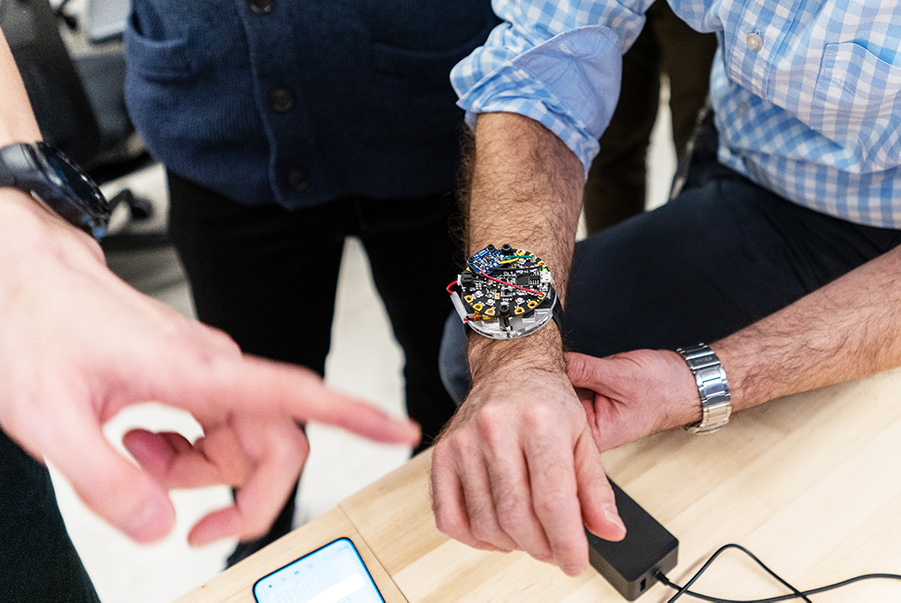A crucial step in their eventual work towards partnering with a Consortium Member on a Launch Project, students recently revealed their work in Dr. Raiti’s Hardware/Software Lab. This class combines prototype building with hands-on user research. Expanded for 2020, many groups are partnered with researchers and subject matter experts at the University of Washington (UW), who help enhance their research while creating custom hardware and software. The majority of projects address a social need and use technology to improve the health, wellbeing, and livelihood of users of all types.
Sleep Tracker
According to the Centers for Disease Control, more than one in three U.S. adults do not get enough sleep on a regular basis. Chronic lack of sleep is associated with high blood pressure, heart disease, and other serious physical and mental conditions. GIX students Jerry Liang, Paulo Goncalves, and Wenbo Zhong partnered with Dr. Jennifer Sonney with the UW Child, Family, and Population Health Nursing department, where she is studying the effects of poor sleep on children with asthma. The team is working to develop a low-cost sensor package that tracks light exposure before and during sleep.

“Initially, we struggled with figuring out the sensors; it was quite difficult.” The device is a wearable watch-like object that tracks movement, sleep, and light lux levels. “The next step is to finalize our custom circuit board, and send it out to get printed,” Jerry added.
“Long term, Dr. Sonney wants children and parents to see the data together, and understand how they can make better, healthier choices that will improve their quality of life. It’s designed for children with asthma, but it can be applied to anyone.”
Indoor Navigation Robot
One of the most intimidating parts of air travel for the elderly is the experience between curb drop-off and successfully arriving at their correct gate. Airports are loud, bustling spaces with high pressure to arrive at the correct place, on time, often a long distance away. To help ease the stress and give elderly travelers more confidence and independence, the Indoor Navigation Robot team, composed Amy Chen, Vivian Wang, Jiali Zhang, and Marc Fang, created a navigation robot that helps guide users from drop-off to their gate.
“We did a survey of about 100 people older than 64, and they said they had a problem navigating in the airport itself,” said team member Amy Chen. “It’s hard for them to find what they need.”
The device, standing about 1.5m tall, is outfitted with a full-color camera sensing system that uses the RealSense SDK and Jetpack to create a virtual map, as well as understand where it is within that space. “Eventually, we want it to show a map just like a navigation app.”
As for the physical design? Their final product draws cues from nature. “We made it a panda shape because people like interacting with things that are cute and fun.”
Grocery Shopping Navigator
People with mild cognitive impairment often have a problem finding things in grocery stores, because they’re large and complicated to navigate,” said Lu Wang. “We wanted to help them.” The team is working with Dr. Carolyn Parsey of the UW Memory and Brain Wellness department for expert knowledge about cognitive impairment. Lu Wang, Ketki Hardas, and Gulnara Sarymbekova have created a hardware/software package that helps users keep track of their grocery list while also finding the products in the store and automatically mapping the most efficient path.
“We built up the database to include all the items and their locations,” she said. “We use machine learning object detection to read aisle numbers and help them find where they are now and where they need to go.”
Teammate Ketki Hardas added, “Our long-term goal is to ease the shopping experience by reducing the number of steps and finding their best path. Right now, they have to update their shopping list in the app, but in the future it’ll internally track and adapt like Google Maps.” What’s next for Milestone 3 and the future of the project? “We’ve been connected with experts and we’re going to do real user testing in grocery stores with real people. We want to make it truly usable in the real world.”


